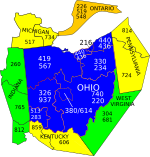Greenhills, Ohio
1930s establishments in OhioHistoric districts in Hamilton County, OhioHistoric districts on the National Register of Historic Places in OhioNational Historic Landmarks in OhioNational Register of Historic Places in Hamilton County, Ohio ... and 6 more
New Deal in OhioPlanned communities in the United StatesSundown towns in OhioUse mdy dates from July 2023Villages in Hamilton County, OhioVillages in Ohio

Greenhills is a village in Hamilton County, Ohio, United States. The population was 3,741 at the 2020 census. A planned community, it was established by the United States government during the Great Depression. Most of the village is a National Historic Landmark for its history as a planned modernist community.
Excerpt from the Wikipedia article Greenhills, Ohio (License: CC BY-SA 3.0, Authors, Images).Greenhills, Ohio
Gambier Circle,
Geographical coordinates (GPS) Address Nearby Places Show on map
Geographical coordinates (GPS)
| Latitude | Longitude |
|---|---|
| N 39.266944444444 ° | E -84.519444444444 ° |
Address
Gambier Circle 53
45218
Ohio, United States
Open on Google Maps









